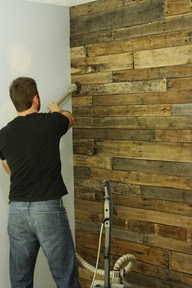 |
| Pallet shelving (Love!) via Remodelista |
The most utilitarian piece of junk has recently stormed the design front in every application from headboard to sofa to wall shelf. The industrial look combined with everybody's favourite price (free) is definitely going to appeal, but there are two things that people may not be aware of. One very, very good, and one potentially very, very bad. Uh-oh.
 |
| This is actually wine crates, but same principle... and cooler IMO... via itsdesigned. |
Years ago I dated a guy briefly who was figuring out how to build his house. He wanted to put as much re-use into it as possible and the creative genius he showed was waaaay out of the box. One of the things that impressed me the most was his research into things that, at the time, were unheard of.
 |
| Pallet pieces cut and placed in a herringbone pattern. Photo from a welltraveledwoman.com |
He decided to create the flooring from lathed pallets as they are found in alleys all the time with signs begging people to take them away. It occurred to him that since these pallets were generally coming from overseas, they would be made from wood that would be considered exotic to us. He took some samples to the woodworking school, and his suspicions were confirmed. Mahogany was everywhere, and many more types were found as well. The process of lathing the pieces down to similar size/thickness was offset by that gorgeous price tag. He was sold. So was I. I have been filing that in the back of my brain for over a decade now, and that is the very, very GOOD thing... exotic hardwood flooring, for FREE. Combined with my desire to reclaim and re-use and generally leave as small a footprint as possible... this is all
good, right?
 |
| Headboard via desire to inspire |
I have used pallets as sofa frames, fencing, and garden plot framing. I am the pallet PR person. It always seems like a good thing to me when you get creative with your sources, and some of these back alley pallets are new wood! The thing that kept me from using too many inside the home was the birth of Thing 1 and Thing 2.
Having kids meant that I started asking questions I would maybe not have otherwise. One year when I was looking for wood for a project, I hauled some pallets to my parent's place to use my stepfather's saws. He asked me if I was aware of the amount of toxins that were sprayed on the pallets before they were shipped overseas to keep any bugs or spores or what-have-you from traveling with them. Enter very, very BAD scenario. The things I was making were intended for the kids room, so I did some research, and
what I found was not very happy.
Painting them out seemed like a good option. I really liked the wood look and feel though. And I am still unclear as to how bad the toxins are if they are painted over. Does it seal them in? Or are we taking chemical reaction on instead? Ugh. I am not here to scare the bejeezus out of anyone, but as I am seeing these everywhere (and loving the look) I thought somebody might want to bring it up. So far I haven't seen the subject of toxins raised anyplace else on the design blog front.

Like any worthy question, this one raises more questions... we all know that many of the furniture and finishing products in our houses conventionally are filled with toxins already, so if we are the type to just go and buy a whatever sofa, then wouldn't it be fine to jump on this trend? Absolutely. Many of the chemical treatments are the same (formaldehyde etc.) as a sofa from Target or Crate & Barrel or wherever, and this is far better for the environment in the sense that it is keeping these pallets out of a landfill. Could you varnish or somehow seal the wood first? Sure, if the woman down at "Colour Your World" is correct, any treatment of that type will seal in the toxins and you don't have to worry.
There is also the option of the
greener pallet. They do exist, and if you are using pallets that were used to ship domestically (within your own country) there is a much greater chance that toxins were not used. There are also
companies that use a heating process to treat their pallets instead of toxins. If you take the time to ask a few questions, not only will you find (hopefully) some answers, but you will have the added benefit of raising awareness with the companies using toxic shipping meathods. The demand for less toxins and environmentally damaging processes in the world from a consumer perspective always starts with asking questions!
 |
| Coffee table from upcycled pallet via Tina's Apt. |
All in all, this is a trend that I LOVE. I really want to see more of this inventiveness and out of the box thinking during the time of economic crisis and the need of the common folk have always been the catalyst of such. I can't wait to see what's next!

























3 comments:
I really liked the article, and the very cool blog
This is very, very fun! I have a friend just starting up her business locally here in Portland, Maine: www.portlandpalletworks.com Check it out! There's some cool stuff being made out there--love the casters.
This is the one thing that puts me off using pallets and not just timber. Thanks for raising the issue. You are right though, most furniture contains toxins that offgas into our homes. think of particle board and chipboard and mdf and all the rest, they are basically saw dust and lots of toxic glue!
But in this case, I think the amount of toxins depends on the pallets. the ones used for international shipping I believe, yes, are treated as are, i think, the ones that are reused. But there are pallets used domestically that they do not treat because they do not intend to reuse them and they just junk them. I know a lot of people like to use pallets for firewood and they have to seek out the untreated ones. People use the treated ones as a free source of treated pine for garden edging too, but in that case they want the sprays.
Post a Comment